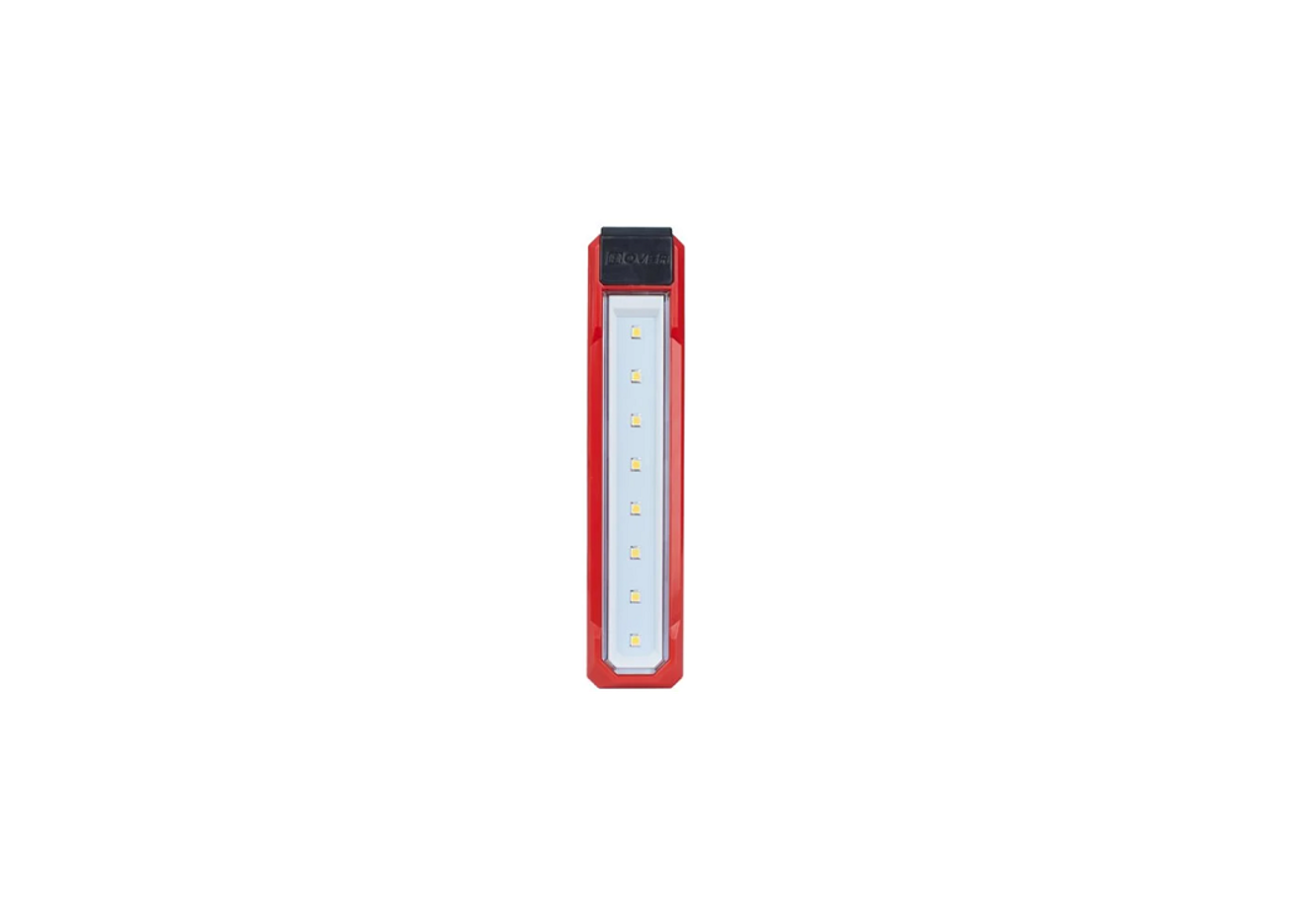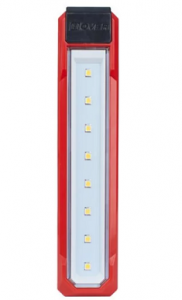Milwaukee RedLithium USB Pocket Flood Light L4 FL User Manual
IMPORTANT SAFETY INSTRUCTIONS
WARNING
READ AND UNDERSTAND ALL INSTRUCTIONS. Failure to follow all instructions listed below, may result in electric shock, fire and/or serious personal injury
SAVE THESE INSTRUCTIONS
- SAVE THESE INSTRUCTIONS – THIS MANUAL CONTAINS IMPORTANT SAFETY AND OPERATING INSTRUCTIONS FOR REDLITHIUMTM USB BATTERIES AND THE
- REDLITHIUMTM USB POCKET FLOOD LIGHT.USE AND CHARGE ONLY REDLITHIUMTM USB BATTERIES IN THIS USB RECHARGEABLE LIGHT. OTHER TYPES OF BATTERIES MAY CAUSE PERSONAL INJURY AND DAMAGE.
- BEFORE USING THE BATTERY AND LIGHT, READ THIS OPERATOR’S MANUAL AND ALL LABELS ON THE BATTERY AND LIGHT.
- AVOID DANGEROUS ENVIRONMENTS. Do not charge battery in rain, snow, damp or wet locations. Do not use battery or charger in the presence of explosive atmospheres (gaseous fumes, dust or flammable materials) because sparks may be generated when inserting or removing battery, possibly causing fire.
- CHARGE IN A WELL VENTILATED AREA. Do not allow smoking or open flames near a charging battery. Vented gases may explode.
- USE ONLY RECOMMENDED ATTACHMENTS. Use of an attachment not recommended or sold by the battery charger or battery manufacturer may result in a risk of fire, electric shock or personal injury.
- TO REDUCE THE RISK OF ELECTRIC SHOCK, always unplug charger before cleaning or maintenance.
- DO NOT BURN OR INCINERATE BATTERY PACKS. Battery may explode, causing personal injury or damage. Toxic fumes and materials are created when battery are burned.
- DO NOT CRUSH, DROP, OR DAMAGE battery. Do not use a battery or charger that has received a sharp blow, been dropped, run over, or damaged in any way (e.g., pierced with a nail, hit with a hammer, stepped on).
- DO NOT DISASSEMBLE. Incorrect reassembly may result in the risk of electric shock, fire or exposure to battery chemicals. If it is damaged, take it to a MILWAUKEE® service facility.
- BATTERY CHEMICALS CAUSE SERIOUS BURNS. Never allow contact with skin, eyes, or mouth. If a damaged battery leaks battery chemicals, use rubber or neoprene gloves to dispose of it. If skin is exposed to battery fluids, wash with soap and water and rinse with vinegar. If eyes are exposed to battery chemicals, immediately flush with water for 20 minutes and seek medical attention. Remove and dispose of contaminated clothing.
- DO NOT SHORT CIRCUIT. A battery will short circuit if a metal object makes a connection between the positive and negative contacts on the battery pack. Do not place a battery pack near anything that may cause a short circuit, such as coins, keys or nails in your pocket. A short circuited battery may cause fire and personal injury.
- STORE in a cool, dry place. Do not store battery where temperatures may exceed 50°C (120°F ) such as in direct sunlight, a vehicle or metal building during the summer.
- TO REDUCE THE RISK OF INJURY, CLOSE SUPERVISION IS NECESSARY when an appliance is used near children.
- STORE IDLE LIGHT OUT OF REACH OF CHILDREN. Warm lights can become hazardous in the hands of children.
- KNOW YOUR LIGHT. Read this manual carefully to learn your light’s applications and limitations as well as potential hazards associated with this type of light.
- MAINTAIN LABELS AND NAMEPLATES. These carry important information. If unreadable or missing, contact a MILWAUKEE® service facility for a replacement
READ AND SAVE ALL INSTRUCTIONS FOR FUTURE REFERENCE.
ADDITIONAL BATTERY SAFETY RULES
WARNING
To reduce the risk of fire, personal injury, and product damage due to a short circuit, never immerse your tool, battery pack or charger in fluid or allow a fluid to flow inside them. Corrosive or conductive fluids, such as seawater, certain industrial chemicals, and bleach or bleach-containing products, etc., can cause a short circuit.
SPECIFICATIONS
Cat. No. L4 FL
USB Input Volts.. 5V DC
USB Input Amps.. ..0.1 – 2.1 AOutput Volts. 4V DCOutput Watts… .4.5WREDLITHIUM™ USB BatteriesVolts.. .4V DCOperating TemperatureBattery and Charger. 4°C to 40°C (40°F to 104°F)Battery and Tool. -18°C to 65°C (0°F to 149°F)
SYMBOLOGY
![]() Volts
Volts![]() Direct Current
Direct Current![]() Amps
Amps
![]() Regulatory Compliance mark (RCM). This product meets applicable regulatory requirements.
Regulatory Compliance mark (RCM). This product meets applicable regulatory requirements.
![]() Do not stare into light
Do not stare into light
![]() Read Operator’s Manual
Read Operator’s Manual
 Class III protection
Class III protection
BATTERY
Maintenance and Storage
Do not expose your battery or cordless tools to water or rain, or allow them to get wet. This could damage the tool and battery. Do not use oil or solvents to clean or lubricate your battery. The plastic casing will become brittle and crack, causing a risk of injury.Store batteries at room temperature away from moisture. Do not store in damp locations where corrosion of terminals may occur. As with other battery types, permanent capacity loss can result if the pack is stored for long periods of time at high temperatures (over 50°C(120°F)). MILWAUKEE® Li-Ion batteries maintain their charge during storage longer than other battery types. After about a year of storage, charge the battery as normal.
WARNING
To reduce the risk of injury or explosion, never burn or incinerate a battery pack even if it is damaged, dead or completely discharged. When burned, toxic fumes and materials are created. Operation
Disposing of MILWAUKEE® Li-Ion Battery
MILWAUKEE® Li-Ion batteries are more environmentally friendly than some other types of power tool batteries. Always dispose of your battery according to federal, state and local regulations. Contact a recycling agency in your area for recycling locations. Even discharged batteries contain some energy. Before disposing, use electrical tape to cover the terminals to prevent the battery from shorting, which could cause a fire orexplosion
REDLITHIUMTM USB POCKET FLOOD LIGHT
WARNING
Use and charge only REDLITHIUMTM USB batteries in this USB rechargeable light. Other types of batteries may cause personal injury and damage.
Inserting the Battery
- Slide the battery door back and lift up.
- Line up the arrow on the battery with the arrow in the compartment and fully insert the battery.
- Close the battery door securely.
Charging the Battery
- Plug your USB cable into a power source such as an AC wall adaptor, computer or car port.
- Lift the rubber cover to expose the micro USB port. Insert the micro USB plug into the micro USB port.
- The indicator light will display the charging status: Red Flashing: Charging, 0-25% charged Orange Flashing: Charging, 25-80% chargedGreen Flashing: Charging, 80-99% chargedGreen Solid: 99-100% ChargedRed/Green Flashing: Damaged or Faulty BatteryIf the light indicator flashes red and green, check that the battery is fully seated into the bay. Remove the battery and reinsert. If the light continues to flash red and green, the battery may be extremely hot or cold, or wet. Allow the battery to cool down, warm up, or dry out and then reinsert. If the problem persists, contact a MILWAUKEE® service facility
Operation
WARNING
To reduce the risk of injury, do not look directly into the light when the light is on.
Press the power button firmly to cycle through High, Low, and Off. The fuelgauge will display the battery life:Red Flashing: 0-10% remainingRed Solid: 10-25% remainingOrange Solid: 25-80% remainingGreen Solid: 80-100% remaining
WARNING
To reduce the risk of injury, always unplug the charger and remove the battery from the charger before performing any maintenance. The charger and battery have no internal serviceable parts. Never disassemble the battery or charger.
Maintenance and Storage
Store your charger in a cool, dry place. As a general practice, it is best to unplug battery chargers and remove batteries when not in use. No battery damage will occur, however, if the charger and battery are left plugged in.
WARNING
To reduce the risk of injury and damage, never immerse your battery or charger in liquid or allow a liquid to flow inside them.
Cleaning
Clean out dust and debris from charger vents and electrical contacts by blowing with compressed air. Use only mild soap and a damp cloth to clean the battery and charger, keeping away from all electrical contacts. Certain cleaning agents and solvents are harmful to plastics and other insulated parts. Some of these include gasoline, turpentine, lacquer thinner, paint thinner, chlorinated cleaning solvents, ammonia and household detergents containing ammonia. Never use flammable or combustible solvents around batteries, charger, or tools.
WARRANTY – AUSTRALIA and NEW ZEALAND
Please refer to Australian and New Zealand warranty supplied with tool. This warranty applies only to product sold by authorised dealers in Australia and New Zealand
SERVICE – AUSTRALIA and NEW ZEALAND
MILWAUKEE® prides itself in producing a premium quality product that is Nothing But Heavy DutyTM. Your satisfaction with our products is very important to us! If you encounter any problems with the operation of this tool, please contact your authorised MILWAUKEE® dealer. For a list of MILWAUKEE® dealers, guarantee or service agents please contact MILWAUKEE Customer Service or visit our website. (Australia Toll Free Telephone Number 1300 645 928) (New Zealand Toll Free Telephone Number 0800 645 928) or visit milwaukeetool.com.au/milwaukeetool.co.nz.
Milwaukee Electric Tool Corporation 13135 West Lisbon Road, Brookfield, Wisconsin U.S.A. 53005Milwaukee Tool (Australia) 21 Kelletts Road, Rowville, VIC 3178Melbourne, AustraliaMilwaukee Tool (New Zealand) 274 Church Street, Penrose, Auckland, 1061, New ZealandDESIGNED BY MILWAUKEE ELECTRIC TOOL CORP. PROFESSIONALLY MADE IN CHINA PRINTED IN CHINA
Read More About This Manual & Download PDF:
[xyz-ips snippet=”download-snippet”]


